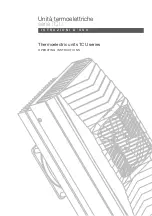
6.2.1 Faulty equipment
If the treatment plant develops
an equipment malfunction which
stops operation (e.g. broken
pump), disconnect the device
from the control unit. Leave the
main power switch on to ensure
uninterrupted aerating. Only
acknowledge the alarm once the
fault has been repaired.
Faulty equipment may also trigger
the wire protection of the device.
You can try to restart the device
by lift ing the wire protection back
into position 1. If the protection is
triggered again, unplug the device
and contact service.
Check the functionality of the
ground fault switch at least once
a year.
6.2.2 Testing equipment using
service socket
The control unit X6 service socket
can be used to test treatment plant
equipment by moving the plug to
the service socket. Aft er testing,
remember to move the plugs in
their correct places.
6.2.3 Equipment diagnostics
and testing via PLC
You can also test the equipment
operations in the logic opera-
tion settings menu. See detailed
instructions in section 4.3, IO
testing.
6.3 Electrical outage
In case of an electrical outage, the
WehoPuts treatment plant control
unit will remember the interrupted
process stage and resume process
normally when power is restored.
6.4 Cleaning process
malfunctions
6.4.1 Odours
If the treatment plant is work-
ing normally, there should be NO
noticeable odours. A slight smell of
wastewater may be present when
the treatment plant transfers un-
treated wastewater from the stor-
age tank to the process tank. If the
treatment plant has a strong odour,
the process tank sludge should be
inspected. If the sludge is black in
colour, the active sludge has died.
This may be due to a long break in
operation, aerating malfunction or
foreign substance in the treatment
plant.
You can determine the
functionality of treatment plant
aeration by moving the compressor
socket (X3) to the service socket
(X6). At this time, immediate
aeration should begin in the
process tank, causing air bubbles.
If this does not happen, contact
service. Aft er inspection, move the
sockets back in their places.
If the active sludge has died, the
treatment plant process tank must
be emptied using a vacuum truck.
Rinsing the tank during cleaning
is also recommended. Aft er this,
the treatment plant can be used
normally.
6.4.2 Foaming
Foaming in the process tank is
normal when the treatment plant
is started. Foaming is due to the
active sludge method starting.
Foaming will settle once operation
continues and the active sludge
strengthens. Momentary foaming
may also appear due to large tem-
perature variations during diff erent
seasons as well as during drastic
load changes. Plentiful use of
detergents will also show as foam.
If foaming is strong and constant,
contact service.
6.4.3 No sludge collected in
sludge bag
Every few cleaning processes, a
small amount of sludge is pumped
from the bottom of the process
tank into the sludge basket. There
is no alarm for the sludge pump
clogging. If no sludge has collected
in the bag, check the sludge pump
operation by moving the pump
plug (X4) into the service socket
(X6). Also test the pump operation
via the operation settings menu
in the soft ware (see section 4.3).
Sludge pumping should begin
immediately. If nothing happens,
order service or clean the pump ac-
cording to section 7.2. Remember
to move the sockets back in their
places!
25
Содержание WehoPuts 10
Страница 30: ...DATE EVENT ALERT SERVICE PROCEDURE 30...
Страница 31: ...DATE EVENT ALERT SERVICE PROCEDURE 31...








































